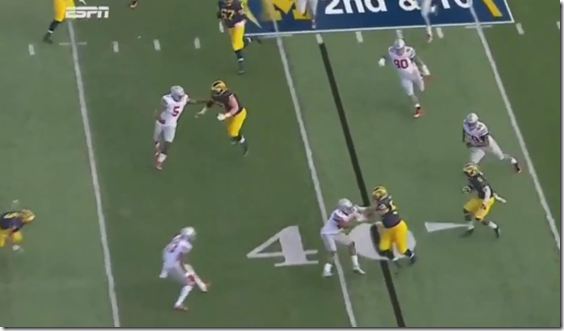This was cool:
It didn't really work; Ohio State's NFL-bound defenders reacted quickly and beat their blocks, but I'm still drawing it up because it was a cool way to mess with the Quarters defense that our two biggest rivals, Ohio State and Rutgers (and Michigan State) run as a base.
Step 1: Play-Action Power
The first thing here is the power pull by the left guard, Braden (#71). That little bit of play-action is meant to get the linebackers reacting to pull, particularly the Sam, or "Star" in OSU's terminology (#43 Darron Lee), and the Mike (#5 Raekwan McMillan). These were two of the quickest linebackers (or in Lee's case hybrids) in the country last year, and the play's success depends foremost on flanking those two with offensive linemen, so getting them to take a false step to the their left is a big deal.
Peppers is set up a bit closer to the line of scrimmage than the QB, which is a key for the defense that Peppers will be coming across (not down), and threatening an outside run (or pass blocking but I think they knew he doesn't do that). His first step indeed is down and in, like he might do that. Then he holds up, at the same moment that Speight pulls the ball back to pass.
Step 2: Show a Tunnel Screen
Let's take a snapshot and see what the power did:
Not much. As soon as they read the pass the linebackers and DBs are all right back where they aligned. However the DL are aggressively getting upfield so they're playing along at least. Braden is set up to take the backside DT to wall off pursuit. The playside DE is allowed to come in free, another signal that the offense will try to run outside, and that holds that DE inside long enough that Peppers can outrun him to the slot.
As the ball goes to Darboh there, Ohio State's defenders start to react to what they're now reading as a screen that attacks the crease. This is a thing a lot of teams run against Quarters defenses because of how it messes with the 1-2 reads.
Remember how Quarters works:
One of the little confusing things you can do against quarters defenders is to stack your receivers or have them cross each other. The DBs have to read #2 to see if he's going vertical (play Cov 4) or horizontal (play Cov 2). Crossing receivers makes that read a little more difficult. Eventually the WRs separate and that's when the read determination is made, but it's still one more bit of analysis to cause paralysis.
The motion-to-stack-to-delay in the slot is messing with the quarters read, and true to form the CB and S stay back and read instead of attacking upfield.
Step 3: Swing out the Peppers
Meanwhile the linebackers are responsible for the RB—Peppers' outside release means the Star, Darron Lee ought to cover him. Michigan would like Darron Lee (the LB at the bottom of the screen) to try to make the play all by himself, meaning he's out of position and about to get walloped by Mason Cole, who's usually a really good downfield blocker. But Lee doesn't get fooled here either. When Darboh gets the ball, Lee races outside into the alley to be the force player.
But this is still fine—if Lee fights inside of Cole, the LB is dead. If Lee keeps leverage, Cole can still blast the much smaller player out of the lane. Glasgow meanwhile whooped past the nose tackle and may yet wall off McMillan.
The hope here is that in all the confusion, you'll catch the Buckeye defenders staying inside to squeeze down Darboh's running room. But they don't.
At the bottom-left you see Apple has defeated Grant's cut block. Lee is set up perfectly to force the run inside and not let Cole push him too far down to create space. Glasgow may be agile but McMillan is already past the hash and too quick to lose that matchup. However Glasgow did a good enough job to get out there that McMillan can't forget about him, which means there's still a lane to be had. And the playside DE, Lewis, has some agility—he checked Darboh then left him to keep pursuit hot—but he's not running down Peppers.
So Harbaugh's little tricky play has Peppers in space and able to pick the side of a Mason Cole vs. hybrid spacebacker block, with the MLB's pursuit too late squeeze down a hole. It's 6 yards before Apple's dodge of Perry fills. Had that block gone right, it'd be Peppers vs a safety who's coming down from the 50 yard line for a lot more.
It would have been fun to see this against a defense not of 2016 Ohio State's caliber. Anyway it's a good example of how Michigan's coaches were emptying the hat of ideas to find a few good matchups against a team they couldn't really play 11 on 11 with.







